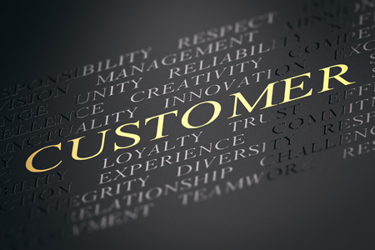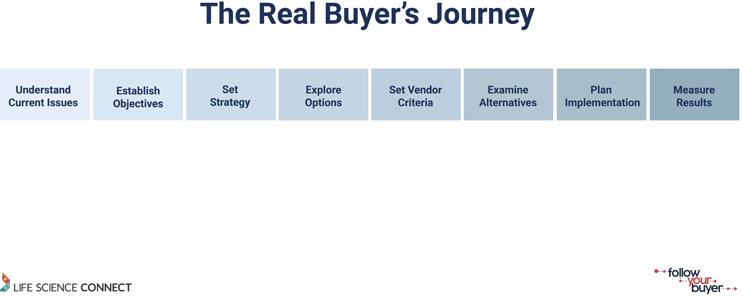Customer-Centered Content Marketing - Part 2

By Perry Rearick, Chief Editor, Follow Your Buyer

This is the second of two articles, with more to come, on customer-centered content marketing. It is intended to help you adopt a content marketing strategy that is aligned with the real buyer’s journey.
Content marketing is not new, but buyer behavior has changed significantly and continues to evolve. The modern buyer’s journey, enabled by convenient, on-demand content, has challenged the effectiveness of traditional B2B marketing and sales. This calls for a significant shift in the way B2B solution provider companies and their marketing and sales teams operate.
First, it is important to understand that potential buyers are on a journey to solve problems, not necessarily buy something. Second, if we want to be considered as a solution provider, we must be a helpful participant in their problem-solving journey, the entire journey.
Buyers navigate an eight-stage journey in their efforts to solve the problems they face and reach the opportunities they’re missing. See figure 1. In part one of this series, we focused on the marketing content that your prospects seek in the first four stages of their journey: understand current issues, establish objectives, set a strategy, and explore options as they seek to solve a business problem they have.

The goal of content marketing is to attract, engage, and retain target audiences. And it is important to remember that the goal of your content marketing strategy for the first four stages of the buyer’s journey is that the vendor criteria set by the buyer in stage five align perfectly with your solution. Now, let’s look at the last four stages of the real buyer’s journey, what your content marketing goals should be, along with the content your prospects desire.
The Last Four Misunderstood Stages of the Real Buyer’s Journey
Remember that odd kid in grade school who was never in his seat, always distracted, and generally an annoyance to those around him. Then one day you discovered that he’s now the CEO of a successful tech company who skateboards to work each day and you recall the wise words of your teacher who insisted he was just misunderstood. Well, that’s the last four stages of the real buyer’s journey. These stages are, set vendor criteria, examine alternatives, plan implementation, and measure results.
By the time your buyer reaches stage five of their journey, set vendor criteria, they have reduced their potential problem-solving partners to several, maybe just one. The buyer has determined that this short list of solution providers have the capabilities and capacity to help them solve their problem. Just as important, they also believe there is enough potential synergy between your organization and theirs to make it happen, this is B2B after all.
Arguably the most critical stage of the last half of the buyer’s journey is stage five, setting vendor criteria. Vendor criteria are developed from the first four stages and will drive the next three. Remember, the goal of your content marketing strategy for the first four stages of the buyer’s journey is that the buyer’s vendor criteria align perfectly with your solution. The goal for the second half of the buyer’s journey is to help the buyer confirm what they discovered about you and help them move forward with confidence knowing you can solve their problem.
Content Aligned to the Last Four Stages of the Buyer’s Journey
I have generally associated content describing products, services, capabilities, features, and benefits as late buyer’s journey content. And while it is content that buyers tend to seek in the late stages of their journey, it is not the only content they need. Let’s walk through the last four stages and the content aligned with each.
Stage 5-Set Vendor Criteria
If you’ve developed and executed a solid content marketing plan for the first four stages of the buyer’s journey, more than likely, prospects will want to speak to you in stage five. But you still must be ready to share content aligned with their needs at this stage.
Remember, buyers have set their vendor criteria and they’re speaking with you because they want to validate what they determined: that you meet their criteria. This will require details regarding your capabilities and examples of how you helped others with problems like theirs. This means easy to understand fact sheets, infographics, spec sheets, case studies, testimonials, and presentations.
Just as important is demonstrating your capacity to support them and that you are a synergistic fit. This important step cannot be automated, and it doesn’t necessarily require sales slicks jammed with taglines. Instead, engage the buyer with the very people with whom they will be working, the ones who will help solve their problem.
Stage 6- Examine Alternatives
Your buyer most likely is considering more than one solution provider in stage six of their journey. When speaking with them directly in stage 5, why not offer to help them with the comparison. Helping them by sharing reputable third-party studies and research on solution providers may be the one thing that differentiates you from the others under consideration.
Stage 7-Plan Implementation
This is a big stage for the buyer and includes the planning and execution of a solution to their problem. They may reference a transformation initiative that is strategic in scope. Your solution may be a supporting effort to their overall outcome. Or perhaps they are making a critical purchase to support a narrow unmet need in their business and your solution fits the requirement. No matter where your solution lies on this continuum, the buyer seeks an efficient on-boarding experience without problems, and they have content needs.
Support the project or on-boarding process with content and tools that inform, instruct, and facilitate collaboration. Shared document folders, real time chat tools, how-to content with video demonstrations are some examples. But create them as intentionally as you do all marketing content. They should be clear, easy to use, and reinforce how important the buyer is to you. Make it personal!
Stage 8-Measure Results
I’ll say it again, B2B buyers are on a journey to solve a problem and once they make a purchasing decision it is important to work with them to measure results against their desired outcomes. Depending on how complex their problem-solving initiative is, this could mean a periodic check-in or regular reports.
If personally checking in with them, do it with the team they worked with and that should include one or more folks they originally spoke with and members of the onboarding team, along with your regular customer service team. Again, this can be automated but is more impactful when you make it personal.
If results are being captured through reporting, keep them simple and easy to understand. Be prepared to walk the buyer through the reports, gain real time feedback, then customize and fine tune your deliverables for their needs. This is the greatest opportunity to create customers for life by delivering value they didn’t expect beyond the buy.
Conclusion
The purpose of content marketing is to attract, engage, and retain target audiences. B2B buyers are on a journey to solve a problem, not necessarily buy something. Sellers who engage in helping the buyer navigate their problem-solving journey far outperform those who are simply trying to sell a solution. But this requires a mindset change in how B2B solution providers approach marketing and sales.
A customer centered content marketing strategy is one that is aligned with all eight stages of the real buyer’s journey. The goal of your content marketing strategy in the first four stages of the buyer’s journey is that the vendor criteria set by the buyer in stage five align perfectly with your solution. The goal for the second half of the buyer’s journey is to help the buyer confirm what they discovered about you and help them move forward with confidence knowing you can solve their problem.
